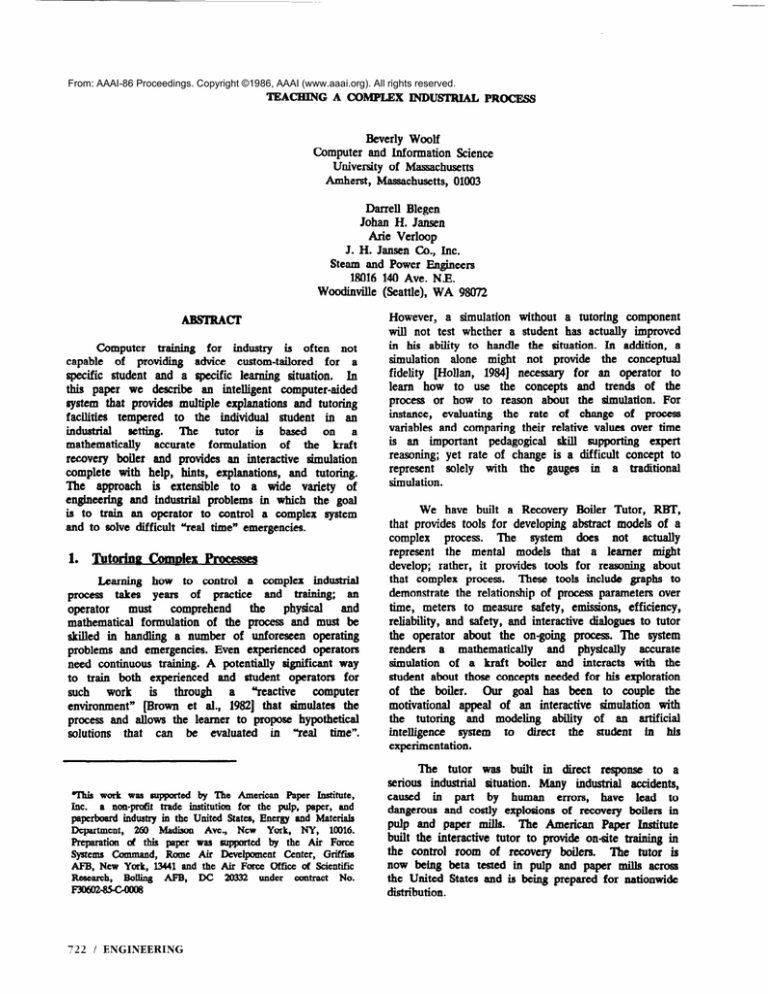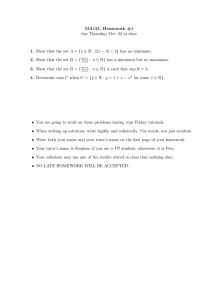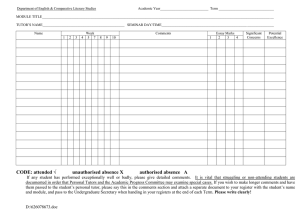
From: AAAI-86 Proceedings. Copyright ©1986, AAAI (www.aaai.org). All rights reserved.
TEACHING
A COMPLEX INDUSTRIAL
PROCBSS
Beverly Woolf
Computer and Information Science
University of Massachusetts
Amherst, Massachusetts, 01003
Darrell Blegen
Johan H. Jansen
Arie Verloop
J. H. Jansen Co., Inc.
Steam and Power Engineers
18016 140 Ave. NE.
Woodinville (Seattle), WA 98072
ABsrRAcr
Computer training for industry is often not
capable of providing advice custom-tailored for a
specific student and a specific learning situation. In
this paper we describe an intelligent computer-aided
system that provides multiple explanations and tutoring
facilities tempered to the individual student in an
industrial
setting. The tutor
is based on a
mathematically accurate formulation
of the kraft
recovery boiler and provides an interactive simulation
complete with help, hints, explanations, and tutoring.
The approach is extensible to a wide variety of
engineering and industrial problems in which the goal
is to train an operator to control a complex system
and to solve difficult “real time” emergencies.
1.
Tutorim Complex Procesq
Learning how to control a complex industrial
process takes years of practice and training; an
the physical and
operator
must comprehend
mathematical formulation of the process and must be
skilled in handling a number of unforeseen operating
problems and emergencies. Even experienced operators
need continuous training. A potentially significant way
to tram both experienced and student operators for
computer
such work
is through
a “reactive
environments [Brown et al., 19821 that simulates the
process and allows the learner to propose hypothetical
solutions that can be evaluated in “real time”.
Tllis
work was suppoad hy The American Paper Institute,
a non-profit trade institutim for the pulp, paper, and
papcrbuard industry in the United States, Energy and Materials
Department, 260 Madison
Ave.,
New
York, NY, 10016.
Frcparation of this paper was suppmtcd by the Air Force
Systems
Canmand,
Rome Air Devclpmnent Center, GriHiss
AFB, New York, 13441 and the Air Force Office d Scientific
Research, Bolliq
AFB, DC XX332 under amtract No.
hC.
722 / ENGINEERING
However, a simulation without a tutoring component
will not test whether a student has actually improved
in his ability to handle the situation. In addition, a
simulation alone might not provide the conceptual
fidelity [Hollan, 19841 necessary for an operator to
learn how to use the concepts and trends of the
process or how to reason about the simulation. For
instance, evaluating the rate of change of process
variables and comparing their relative values over time
is an important pedagogical skill supporting expert
reasoning; yet rate of change is a difficult concept to
represent solely with the gauges in a traditional
simulation.
We have built a Recovery Boiler Tutor, RBT,
that protides tools for developing abstract models of a
complex process. The system does not actually
represent the mental models that a learner might
develop; rather, it provides tools for reasoning about
that complex process. These tools include graphs to
demonstrate the relationship of process parameters over
time, meters to measure safety, emissions, efficiency,
reliability, and safety, and interactive dialogues to tutor
the operator about the on-going process. The system
renders a mathematically and physically accurate
simulation of a kraft boiler and interacts with the
student about those concepts needed for his exploration
of the boiler. Our goal has been to couple the
motivational appeal of an interactive simulation with
the tutoring and modeling ability of an artificial
intelligence system to direct the student in his
experimentation.
The tutor was built in direct response to a
serious industrial situation. Many industrial accidents,
caused in part by human errors, have lead to
dangerous and costly explosions of recovery boilers in
pulp and paper mills. The American Paper Institute
built the interactive tutor to provide on&e training in
the control room of recovery boilers. The tutor is
now being beta tested in pulp and paper mills across
the United States and is being prepared for nationwide
distribution.
RECMJERV
BO ILER
TUTOR
I
1
SAFETY
EMISSIONS
I
1
FEEDWATER-
FUEL---RELIABILITY
I
I II
Figure Iz Seztional View of the Recovery RoiIer.
2.
The Recoverv
Boiler
Tutor
A recovery boiler is an extremely Complex
machine found in hundreds of pulp and paper mills
around the world. Figure 1, from the RBT screen,
pictures a typical boiler and some of the meters used
by an operator to control the process. The actual
boiler can cost up to $70 million and can be up to 20
stories high. Its function is to prowmes the spent black
liquor that can be produced in a pulp mill, up to I!500
to&day, and to allow recovery and reuse of the
pulping chemicals. It is a process in which hot and
molten inorganic chemicals may lead to smelt/water
and combustible gas explosions, endangering life and
property.
The
god
behind the tutor is to challenge an
operator to solve boiler problems and to maintain his
incentive to “play” with the tutor. The operator is
encouraged to move setpoint controllers and to watch
the results of his actions on the animated boiler or
control board. The tutor monitors the operator’s
freewheeling trials and errors and provides help, hints,
explanations, and tutoring when needed or requested.
An example interaction*
between the student
and tutor is shown in Fiie
2. As the operator
changes setpoint controllers and requests information
about the boiler, the tutor selectively discusses the
optimality of his actions (we show how in Section 3)
and suggests how he might better focus his action or
better utilixe his data. An important feature to note
about this dialogue is that at any point during the
,
?.udiaI~ofF~2wasnotactua~producedin~ti
language; student inprt was handkd thraugh maw (~yzurc 3)
and tutor OutpIt produced by cutting text frum
tmergcncyqecific text filts loaded when the emcrgt~lcywas
invoked.
A partial blackout is in progress and it will
[Note:
lead to deterioration of the combustion process if no
action is taken. Meters indicate that CO, fQ
and 0,
readings are abnormally high.]
Tutor: What action are you going to take?
Student: Check smelt spout cooling water. [Student’s
action does not result in a change in the
boiler.]
Tutor: It looks as though the liquor isn’t burning . . .
Student: Help. What is going on? [Student requests
help.]
Tutor: A partial blackout is occurring and this causes
TRS, CO, S%, and 02 to increase. Steam
flow and steam temperature are dropping. I
think part of the bed is not burning.
Student: Rod the primary air ports.
[A small
improvement in the boiler readings can be
observed.]
Tutor: Your action is correct; however, at this time
rodding alone is not effective . . .
Student: Raise the liquor temperature.
[Student’s
action does not reverse the emergency and a
new alarm buzzer sounds]
Tutor: Rodding the air port apparently was not enough
to undo the blackout.
Student: Increase the oil fuel supply. [Stu&nt’s action
reverses the emergency.]
Tutor: That solved the problem alright. Good thinking.
Analysis of the problem: You had a partial blackout
caused by plugged primary air ports and a cold bed.
Partial blackout can be effectively treated through a
combination of rodding the primary air ports and
adding more heat. The problem can be avoided by
keeping the air ports clean.
Flgore2:DlalogueEetweenTptorandoperator.
AI AND EDUCATION
I 723
I
RECOVERY
BOILER
TUTOR
I
SAFETY
I
EMISSIONS
P---i
I’,
I’I
I
EFFICIENCY
1
I
I’I
-
-
-
-
-
III
d---
-2QA
FEEDWA’
4
I
RELIABILITY
IQgIlreI:Focuse!dviewoftheFlrcBed.
hulated
emergency there are a large number of
actions an operator might take and, as the problem
worsens, an increasing number of actions that he
should take to correct the operating conditions. Thus,
an immediate and correct response might require only
one action, such as rodding the primary air ports, but
a delayed response causes the situation to worsen and
requires the addition of auxiliary fuel.
The operator interacts with the tutor through a
hierarchy of menus, one of which is shown in Figure
3. This menu allows an operator to select a physical
activity to be performed on the boiler, such as to
check for a tube leak or to rod the smelt spout.
Another menu allows the operator to select a
particular computer screen, such as the alarm board or
control panel board.
What
I%-e
You
Going
to
Do
Determine
source
of dilution
Check
instrumentat
ion
Check
dissolving
tank
agitators
Rod smelt
spout
Use portable
auxiliary
burner
Remove
liquor
guns
Put
in liquor
guns
Clean
liquor
guns
Rod primary
air
ports
Rod secondary
air
ports
Check
smelt
spout
cooling
water
St art
standby
f eedwat er pumps
Restore
water
flow
to deaerator
Quit
Flgurc3:MenutoSeIectoPhysicaITosktoPerf~
on the Boiler.
:...........:.
ii;i;iiii;;;:,;
...............I
While the simulation is running, the operator can
view the boiler from many directions and can focus in
on several components, such as the fiie bed in Figure
4. The tutor provides assistance through
visual
clues,
such as a darkened smelt bed; acoustic
clues,
ringing
alarm buzzers, textual help, explanations, and dialogues,
such as that illustrated in Figure 2. The operator can
request up to 30 process parameters on the complete
panel board, Figure 5 or can view an alarm board
The tutor allows the student to change
(not shown).
20 setpoints and to ask menued questions such as
What is the problem?“, “How do I get out of it?“,
‘What caused it?“, and ‘What can I do to prevent
it?.“’
The operator can request meter readings,
physical and chemical reports, dynamic trends of
variables. All variables are updated in real time (every
1 or 2 seconds).
The student can initiate any of 20 training
situations, emergencies, or operating conditions or ask
that one be chosen for him. He might also trigger an
emergency as a result of his actions on the boiler.
Once an emergency has been initiated, the student
should adjust meters and perform actions on the
simulated boiler to solve the emergency.
In addition to providing information about the
explicit variables in the boiler, RBT provides
information about implicit processes through reasoning
tools, with which an operator can understand and
reason about the complex processes. One such tool is
composite meters (left side of Figures 1 and 5). These
meters record the state of the boiler using synthetic
pfficiency,
and
measures for safetv, B,
g&&l&
of the boiler. The meter readings are
Thcacfourqucsti~afcanswcrcdbycuttingtcxtfnmrafile
which was loaded with the spdfic emergency. These qudons
do not pmidc
the basia d the tutor% kmnvkdgc
rqxcscntatim, which will be dimmed in Sccticm 32
724
/ ENGINEERING
RECOVERY
BOILER
TUTOR
l-KG-l
STEAM
1007
SRFETY
h-d
755
:
EMISSIONS
FLUE
FEEDWATER
Mpph
480.3
"F
300
1208
wig
attemp
1.9
DCE Dilution
0
gym
Sootblower
36.0
MPPll
Pressure
TRS
wm
Gas
670
wm
Bank
LIQUOR
300
44
5.0
DISSOLUING
TANK
LeuelIxZ
Density(x1
86
96
Fp
calculated from complex mathematical formulae that
would rarely, if ever, be used by an operator to
evaluate the same characteristics of their boiler. For
instance, the safety meter is a composition of seven
independent parameters, including steam pressure, steam
flow, steam temperature, feedwater flow, drum water
level, firing liquor solids, and combustibles in the flue
gas. Meter readings allow a student to make inferences
about the effect of his actions on the boiler using
characteristics of the running boiler. These meters are
not presently available on existing pulp and paper mill
control panels; however, if they prove effective as
training aids, they could be incorporated into actual
control panels.
Other reasoning tools include trend analyses,
Figure 6, and animated graphics, such as shown in
Figures 1 and ‘4. Trend analyses show an operator
how essential process variables interact in real time by
allowing him to select up to 10 variables, including
liquor flow, oil flow, and air flow, etc, and to plot
each against the others and time. Animated graphics,
another reasoning tool, are provided as a part of every
view of the boiler. These animations include moving
realistic drawings of components of the boiler, such as
steam, fire, smoke, black liquor, and fuel.
*
Multiple concepts and processes were represented
in RBT, mrne procedurally, some declaratively, and
some in both ways. For example, emergencies in the
steam boiler were first represented as a set of
mathematical formulae so that process parameters and
meter values could be produced accurately in the
simulation. Then these same emergencies were encoded
within the tutor’s knowledge base as a frame-like data
structure with slots for preconditions, optimal actions,
gym
"F
% Sol
stm/liy
psi
300
Flowlypm)
463
S: ‘Ibe Complete
SO2
PP~
Temperature
ID Fan
MPPIi
=*
CO
mm
Flue
EFFICIENCY
RELIABILITY
GfiS
Cantrd
Econ
DCE
MAKE-UP
194.1
291
240
65.0
3.68
0
Pad.
and conditions for solution satisfaction so that the
tutor could evaluate and comment upon the student’s
solution.
RBT can recognize and explain:
l
equipment and process flows,
l
emergencies operating problems as welI
as normal conditions,
l
solutions to emergencies and operating
problems,
0 processes for
and
0 tutoring
student.
implementing
strategies
for
solutions,
a&sting
the
Four modules were used to represent this knowledge:
simulation, Amledge
base,
student
wmdel,
and
instructional stratqdes.
The dmufation uses a mathematical foundation to
depict processes in a boiler through meter readings and
four animated views of the boiler. It reacts to more
than 35 process parameters and generates dynamically
accurate reports of the thermal, chemical, and
environmental performance of the boiler (not shown)
upon request. An alarm board (not shown) represents
25 variables whose button wil.l turn red and alarm
sounded u&en an abnormal condition exists for that
parameter.
The simulation
is interactive
and
inspectable in that it displays a “real time” model of
its process, yet allows the student to “stop” the process
at anytime to engage in activities needed to develop
his mental models mollan et al., 19&F]. The operators
who tested RBT mentioned that they like being able
AI AND
EDUCATION
I 725
to stop the process to ask questions or to explore
boiler characteristics.
One advantage of a formal representation of the
process is the availability of a “database” of possible
worlds into which information based on typical or
previous moves cm be fed into the simulation at
anytime prawn et al., 19821 and a solution found. In
this way, a student’s hypothetical cases ~811 be
proposed, verified, and integrated into his mental
model of the boiler.
The knowledge
base contains preconditions,
postconditions, and solutions for emergencies or
operating conditions, described as Scenarios. Scenarios
are represented in frame-like text files containing
preconditions, postconditions, and acceptable solutions
for each scenario. For example, in Lisp notation, a
true blackout would be described as:
preconditions:
(or (c= blackout-factor 1)
(C heatinput soo0))
postconditions:
(or (increasing 02)
(decreasing steamflow)
(increasing TR!3)
(increasing CO)
(increasing 2502))
solutiollsatisfaction:
(and (= blackout-factor 1)
(> heatinput !5200))
qn;eiattrins
i.n RBT
fJanscn
726
details
about the steam
and chemical
and the boiler simulation
capabilities
can
et al.. m&l.
/ ENGINEERING
The efficiency of the student’s action is
evaluated both through the type of action performed,
such as $creasina oa or jncreasina steamflow for a
true blackout, and the effect of that action on the
boiler. Thus, if an inappropriate action nevertheless
resulted in a safe boiler, the student would be told
that his action worked, but that it was not optimal.
The student tnudef records actions carried out by
the student in solving the emergency or operating
problem. It recognixes correct as well as incorrect
actions and identifies each as relevant, relevant but not
optimal, or irrelevant.
The instnrcrionuf sfru2egies contain decision logic
and rules to guide the tutor’s intervention of the
operator’s actions. In RBT, the intent has been to
“subordinate teaching to learning” and to allow the
student to experiment while developing his own criteria
about boiler emergencies. The tutor guides the student,
but does not provide a solution as long as the
student’s perfprmance appears to be moving closer to a
precise goal.
Represented as if/then rules based on a specific
emergency and a specific student action, the
instructional rules are designed to verify that the
student has ‘asked” the right questions and has made
the correct inferences about the Saliency of his data.
Respmses are divided into three categories:
parameters
be found in
Redirect student: “Have you considered the rate of
increase of 021”
“If what you suggest is true, then how would
you explain the low emissions reading?”
Synthealze data: “Both 02 and TRS have abnormal
trends.”
“Did you notice the relation between steam flow
and liquor flow?”
Chfinu
action: “Yes, It looks like rodding the ports
worked this time”.
The instructional strategies are designed to
encourage an operator’s generation of hypotheses.
Evidence from other problem solving domains, such as
medicine [Bat-rows and Tamblyn, 19801, suggests that
students generate multiple (usually 3-5) hypotheses
rapidly and make correct diagnoses with only Z3 of
the available data,’ The RBT tutor was designed to
be a partner and co-solver of problems with the
operator, who is encouraged to recognixe the effect (or
lack of same) of his hypotheses and to experiment
with multiple explanations of an emergency. No
penalty is exacted for slow response or for long
periods of trial and error problem solving.
This approach is distinct from that of Anderson
et al., [198ij and Reiser et al., [19851 whose geometry
and Lisp tutors immediately acknowledge a incorrect
student answers and provide hints. These authors
argue that erroneous solution paths in geometry and
Lisp are often so ambiguous and delayed that they
might not be recognized for a long tune, if at all, and
then the source of the original error might be
forgotten.
Therefore,
immediate
computer tutor
feedback is needed to avoid fruitless effort.
However, in industrial training, the trainee must
learn to evaluate his own performance from its effect
on the industrial process. He should trust the process
itself to provide the feedback, as much as is possible.
In RBT we provide this feedback through animated
simulations, trend analyses, and “real-time” dynamically
updated meters. The textual dialogue from the tutor
provides added assurance that the operator has
extracted as much information as possible from the
data and it establishes a mechanism to redirect him if
he has not.
4.
~veIonmental Issues
RRT was developed on an IBM PC AT (512 RR
RAM) with enhanced graphics and a 20 MB hard disk.
It uses a math co-processor, two display screens (one
color), and a two key mouse. The simulation was
implemented in Fortran and took 321 ICB; the tutor
was implemented in C and took 100 KB.
Although we tried to implement the tutor in
Lii,
we found extensive interfacing and memory
problems, including segment sixe restrictions (64k),
incompatibility with the existing Fortran simulator, and
addressable RAM restrictions (64OK). To circumvent
these problems the tutor was developed in C with
many Lisp features implemented in C, such as
functional calls within the parameters of C functions.
Meter readings and student actions were transferred
from the simulation, in Fortran, to the tutor, in C,
through vectors passed between the two programs.
5. Jhiluationq
The tutor has been well-received thus far. It is
presently used in actual training in the control rooms
of several pulp and paper mills throughout the US.
Formal evaluation will be available soon. However,
informal evaluation suggests that working operators
enjoy the simulation and handle it with extreme care.
They change parameters slowly, with great intention,
and use small intervals in adjusting meters. They
behave as they might at the actual control panel of
the pulp mill; they check each action and examine
several meter readings before moving on to the next
action.
Roth experienced and novice operators engage in
lively use of the system after about a half hour
introduction. When several operators interact with the
tutor, they sometimes trade “war stories” advising each
other about rarely seen situations. In this way,
experienced operators frequently become partners with
novice operators as they work together to simulate and
solve unusual problems.
.hfcdical atudenta have been found to ask 60% of their
questions while wrching for new data and obtain 75% of their
sign&ant
information within the first 10 minutes after a
problem ia stated b
and Tamblyn, 19&l].
AI
AND
EDUCATION
/ 727




